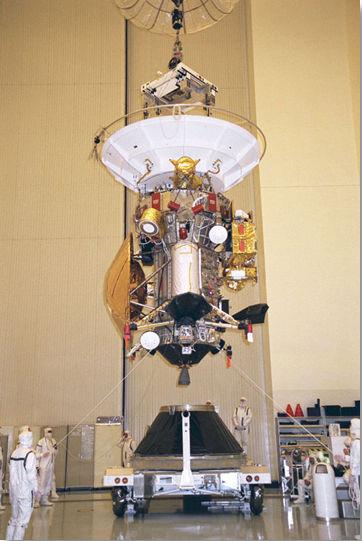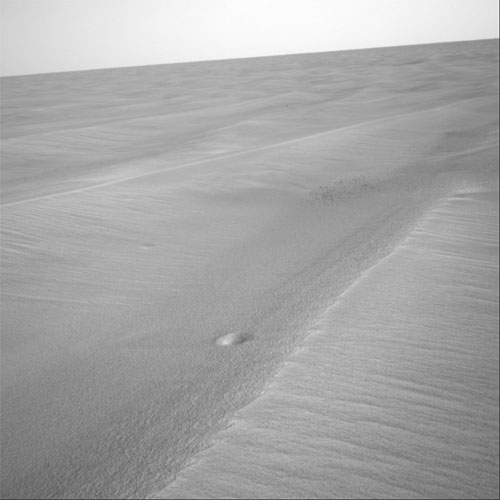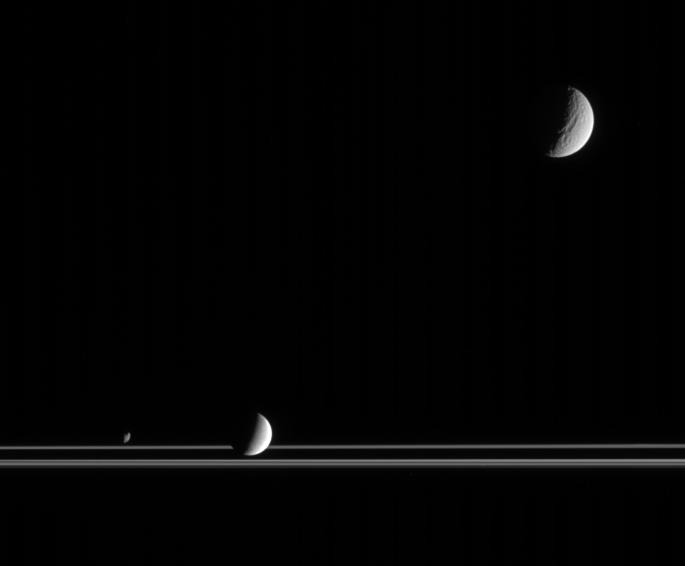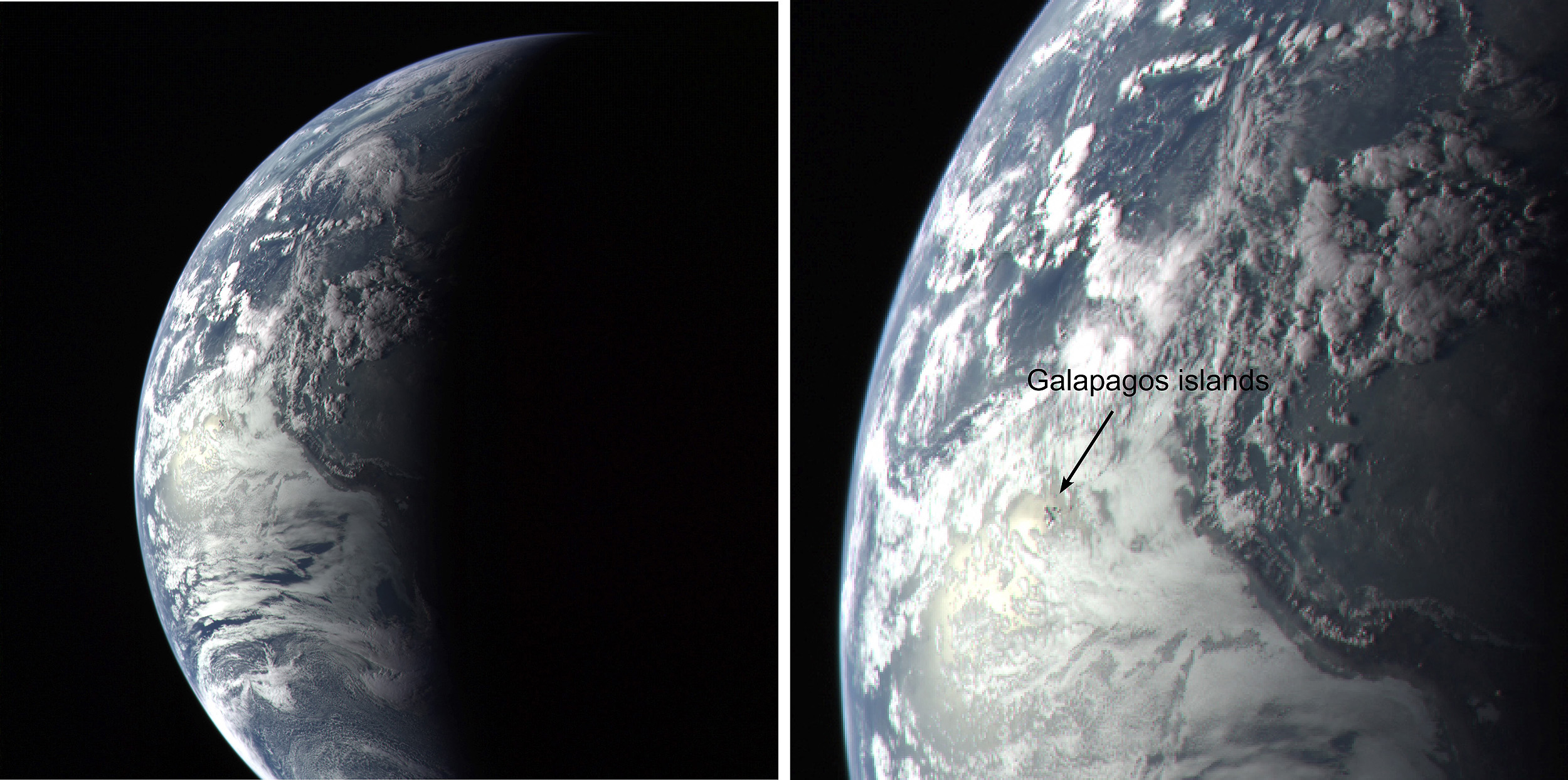
by Sean Sullivan
Photographs courtesy of NASA or NASA/JPL-Caltech
This presentation is intented to provide an introduction to the solar system and planetary exploration. You may expect a tour that goes through the list of planets -- Mercury, Venus, Earth, Mars ... but we're going to take a different approach, and hopefully this will help illuminate not only what the solar system is like, but why. This is a story that ties together astronomy, chemistry, geology and biology.
The solar system formed abour 4.5 billion years ago, from a giant cloud of galactic dust and gas. Astronomers have measured the relative frequency of the elements in the universe, and let's look at a ton of typical interstellar matter, the raw materials that go into stars and planets.

Helium is an inert element that doesn't form chemical bonds. The two most common chemically reactive elements in the universe are hydrogen and oxygen, so naturally, what you get by combining them will be something important. What is that? Water! The importance of water in biology is often discussed, but water is also important from an astronomical perspective. Just based on the abundance of hydrogen and oxygen, we could expect water to be a common substance found throughout the universe. This is true, and water's properties have an important effect on what planets are like.
TYPES OF PLANETS
The two most common elements in the universe -- hydrogen and helium -- are light gasses that easily evaporate into space. Even the Earth's gravity isn't strong enough to hold onto these elements, because the warmth of the sun makes molecules or atoms of these elements move very fast, sometimes fast enough to escape the planet into interplanetary space. I know that sounds incredible, because we have to use rockets to get stuff away from our planet, but that's really what happens over long periods of time.
Looking at our table, hydrogen and helium make up 98 percent of the material in the universe! so the properties of a new planet will be largely based on whether it holds or loses these two elements.
If a new planet can keep its hydrogen and helium, the makeup of that planet will be dominated by these two substances, because they make up 98 percent of the planet's substance. Everything else makes up a relatively unimportant two percent of the new world. Helium is chemically inert, and stays as solitary helium atoms, while hydrogen will bond and form molecular hydrogen (H2). Both helium and molecular hydrogen are light gasses, so the new planet will be a gaseous world, entirely unlike our everyday image of a "planet". There will be no solid surface within thousands of miles of the cloud tops. The result is a "gas giant" planet. There are four in our solar system -- Jupiter, Saturn, Uranus and Neptune.
On the other hand, if a new planet can't hold onto hydrogen and helium, only 40 pounds remain from the original 2,000 pounds of building materials. A little hydrogen can be retained in molecules like water, but the vast bulk of the hydrogen has nothing heavy to bond with, and simply goes away. The result is a much smaller planet, made up of the remaining heavier elements.
Looking back at our table, let's ignore neon, becuase it's another light inert element that usually evaporates along with the hydrogen and helium.
With hydrogen, helium and neon gone, the three most abundant elements are oxygen, carbon and nitrogen. All three elements react with super-abundant hydrogen to form specific chemicals: oxygen makes water, carbon makes methane, and nitrogen makes ammonia. These three substances -- water, methane and ammonia -- are rather similar in some respects. They are gasses (or can turn into gasses) at Earthlike temperatures, but can be solid in colder places. Astronomers call these three substances "ices" or "volatiles". These substances are easier to retain than hydrogen and helium, and if a planet can hold onto substantial quantities of these ices, you get a world made largely out of water, methane and ammonia. The result is a world like Pluto, or the moons of Jupiter and Saturn, or even comets.
Finally, if a new planet can't hold onto significant quantities of ices, you get a world made primarily from the next three elements on our list: magnesium, silicon and iron. These elements, in chemical bonds with some of the more abundant elements, make rock. For example, silicon plus oxygen makes quartz, one of the most common substances on Earth. The result is an Earth-like planet made out of rocks, such as the Earth, Mars, or the Moon.
What makes the difference is temperature. Planets near the sun are warm, making it easy to lose hydrogen, helium and the ices, and you get rocky worlds. Farther from the sun, new planets can hold onto hydrogen and helium if they get large enough to develop a significant gravity field, and you get the gas giant worlds. But if a small world forms in the outer solar system, there isn't enough gravity to hold the light gasses, and you get an icy world. In summary, this is why there are three basic types of worlds in the solar system -- rocky worlds like Earth, gas giant worlds like Jupiter, and icy worlds like Pluto and the moons in the outer solar system.
REVIEW OF THE PLANETS
With this perspective, let's take a look at the solar system.
The warm inner solar system contains four planets -- Mercury, Venus, Earth and Mars -- together with Earth's Moon, which is a planet-sized world in its own right, and the two tiny moons of Mars. All of these are rocky worlds with a solid surface you could walk on. There are important differences. Mercury and the Moon have no atmosphere, so the surface of these worlds is exposed to the vacuum of space. Venus has a thick atmosphere that traps heat, making the surface hotter than a kitchen oven. Mars is the most Earth-like place among the other worlds in the solar system.
The cold outer solar system features four gas giant planets, each the center of a mini-solar system of numerous moons. The largest planet, Jupiter, is several hundred times more massive than the Earth. In fact, some of Jupiter's and Saturn's moons are larger than the smallest planets.

Animated image of Jupiter's clouds in motion
Of course, with Saturn everyone thinks of the rings. The rings are enormous -- about 175,000 miles wide -- and yet exceedingly thin in comparison, less than a mile thick. The rings are made up of countless moonlets and chunks of ices orbiting the planet.
In recent years, astronomers have been discovering lots of new objects in the outer solar system, beyond Pluto. It now appears that there is a population of objects out there, covering the whole range from a few objects of Pluto's size (over a thousand miles across) down to comets only a few miles across. These are icy worlds and objects, not large enough to retain hydrogen or helium, and made primarily of water ice and other ices such as methane.
One of these newly-discovered objects is larger than Pluto, naturally leading to questions about whether this is "the tenth planet". The answer is no one knows -- we've got a really good idea what the new object is like, but it turns out people don't agree over what the word "planet" means. The solar system has objects of all sizes. Everyone agrees that the biggest worlds are planets, but that word isn't appropriate for the smallest objects, such as asteroids only a few miles across. The problem is that there's no easy way to draw a line and say "everything on this side is a planet, everything on that side isn't a planet". It's a problem with language, not astronomy. What we can say is that some of these new worlds are cold places, a thousand miles across, orbiting far from the Sun where sunlight is thousands of times weaker than it is on Earth.
The asteroids, mostly between the orbits of Mars and Jupiter, are small objects that are mostly rocky or icy. Most asteroids have irregular shapes, like large boulders, because their gravity is not strong enough to force the material into a sphere. But the largest asteroids are round worlds, and some people think that certain objects we call asteroids should really be counted as planets.
PLANETARY EXPLORATION
So, how do we find out about these worlds?

Cassini spacecraft before launch
Early planetary exploration focused on our nearest neighbor, the Moon. The first probes, called "Ranger" spacecraft, were fitted with cameras and simply smashed into the moon's surface, sending back pictures all the way down. And of course, the Apollo program sent 12 astronauts to the surface of the Moon during the 1960's and 1970's.
Mars has been a natural target for exploration, since it's the only other place in the solar system where a rocky surface meets an atmosphere, with a temperature within 200 degrees of the range of liquid water. Mars is the only other place even remotely resembling Earth. But it's very different, the air contains no oxygen and the atmosphere is incredibly thin. Our best sense of Mars comes from two rovers that are currently exploring its surface, Spirit and Opportunity.

Spirit photograph of Mars surface
The surface of Mars is a varied place, with rocks, canyons, sand dunes, polar ice caps, and mountains. And it also has craters. Earth also gets craters -- a few are well-preserved, such as Meteor Crater in Arizona -- but the effects of wind and water remove Earth's craters fairly quickly. Mars, with a thinner atmosphere, gets hit more often and the craters tend to remain in good condition for a longer time. Here's a photo from the Opportunity rover, showing a small crater in a sand dune -- this crater is less than a foot across!

Opportunity photograph of a tiny crater on Mars
A set of four spacecraft were launched in the 1970's towards the outer solar system -- Pioneers 10 and 11, and Voyagers 1 and 2. These spacecraft flew past the outer planets, taking photos of planets, moons and rings, giving us our first close-up views of these cold worlds. These "flyby" spacecraft were followed in the 1980's and 1990's by two large spacecraft that went into orbit -- Galileo around Jupiter, and Cassini around Saturn -- where they could observe for years, including numerous close flybys of the many moons.
Galileo found that one of Jupiter's four large moons, Europa, is a particularly interesting world. Europa is an icy world, but under the ice there seems to be a giant ocean of liquid water. Of all the places in the solar system where we might find life, this is one of the best candidates.
Cassini recently found that one of Saturn's moons, Enceladus, apparently has some volcano-like structures with liquid water near the surface, so this is also a place where we might look for life. But Enceladus is a tiny world, only 300 miles in diameter, and it's hard to imagine such a cold and tiny place keeping a comfortable abode for life.

Three moons of Saturn (Janus, Enceladus and Tethys)
Some spacecraft have flown past asteroids, when their trajectories through the solar system provided an opportunity to make a close approach.

Galileo photograph of asteroid Ida with its tiny
moon Dactyl
A new spacecraft with a powerful camera recently entered orbit around Mars, and spacecraft are currently en route to several planets, including Mercury and Pluto. In addition, new missions are planned, including a spacecraft called Dawn that will investigate several of the largest asteroids.

Comparison of Vesta, Eros and Ceres
To communicate with spacecraft exploring the solar system, we use radio. Spacecraft have to make their own power, so their radio signals are not particularly strong. To pick up these weak radio signals from distant planets, we use giant antennas such as the "Deep Space Network" operated by NASA.
Spacecraft relay lots of information back to Earth. They take photographs, like digital camera photos, that are sent back as image files. In addition, they report back about the health of spacecraft systems, and collect other kinds of scientific data about their environment. But sometimes things go wrong. Galileo's radio antenna failed to open properly, so when it reached Jupiter, it had to return information with a non-directional radio signal that was never intended for that purpose. As a result, Galileo was only able to send back a fraction of the planned photographs. Fortunately, Cassini has worked well, and we are getting a stream of absolutely stunning images from Saturn.
And then there's Earth.
Earth as seen from the space shuttle
COMET SCHWASSMANN-WACHMANN 3
Next month, a small comet will pass unusually close to Earth -- only about 25
times farther away than the Moon. No comet has come this close in the past 20
years. Due to its proximity, this comet may be visible to the unaided eye for
several days. Closest approach is expected around May 12.
What makes this comet particularly unsusal, besides its close passage, is that
it's falling apart. The comet has been breaking into fragments, as the warmth
of the sun evaporates its icy material. As a result, we may see a stream of
several comets close to each other in the night sky. Individual fragments flare in
brightness when a large chunk falls away, and some fragments fade into
invisibility as they disintegrate into space. It's hard to know what to
expect, but it's worth keeping an eye on space news, and perhaps trying to see
if you can find the comet in the night sky.
Credit for Hubble images: NASA, ESA, H. Weaver (JHU/APL),
M. Mutchler and Z. Levay (STScI); Credit for ground-based image: G. Rhemann
and M. Jager
For more information about the solar system, you can visit the Wikipedia entry for the Solar System.

Earth as seen from the Messenger spacecraft
Hubble and ground-based telescopes view comet
Hubble close-up view of comet fragments